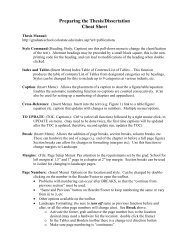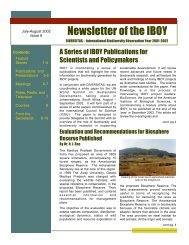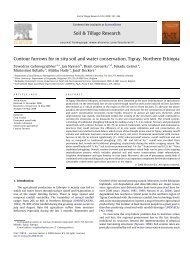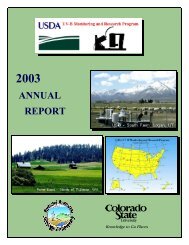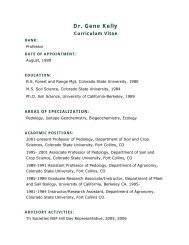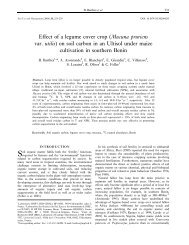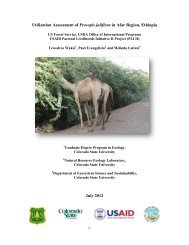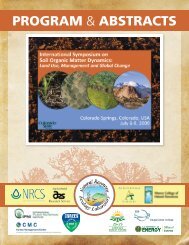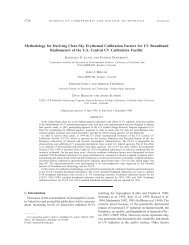The Ellis paradigm â humans, herbivores and rangeland systems
The Ellis paradigm â humans, herbivores and rangeland systems
The Ellis paradigm â humans, herbivores and rangeland systems
You also want an ePaper? Increase the reach of your titles
YUMPU automatically turns print PDFs into web optimized ePapers that Google loves.
African Journal of Range & Forage Science 2004, 21(3): 191–200Printed in South Africa — All rights reservedCopyright © NISC Pty LtdAFRICAN JOURNAL OFRANGE & FORAGE SCIENCEISSN 1022–0119<strong>The</strong> <strong>Ellis</strong> <strong>paradigm</strong> — <strong>humans</strong>, <strong>herbivores</strong> <strong>and</strong> rangel<strong>and</strong> <strong>systems</strong>Michael CoughenourNatural Resource Ecology Laboratory, Colorado State University, 1499 Campus Delivery, Fort Collins, Colorado 80523-1499,United States of Americae-mail: mikec@nrel.colostate.eduReceived 10 Feburary 2004, accepted 6 September 2004<strong>The</strong> scientific <strong>and</strong> conceptual contributions Jim <strong>Ellis</strong> made throughout the course of his career reveal a logical progression towardsincreased underst<strong>and</strong>ing of pastoral eco<strong>systems</strong> worldwide. Research in wildlife, large <strong>herbivores</strong>, <strong>systems</strong> ecology <strong>and</strong> energyflows through grazing eco<strong>systems</strong> formed the basis of his approach. A leader of the South Turkana Ecosystem Project (STEP), heshowed the adaptive basis for opportunistic <strong>and</strong> spatially extensive resource use in temporally <strong>and</strong> spatially variable environments.After the STEP, he examined pastoral eco<strong>systems</strong> in northern <strong>and</strong> central Asia <strong>and</strong> elsewhere in Africa. Spatial extensivity, or scale,emerged as being critically important to pastoral ecosystem function. Livestock development schemes based upon inappropriateecological <strong>and</strong> economic assumptions are all too often ecologically <strong>and</strong> economically unsustainable. However, a new <strong>paradigm</strong> ofpastoral ecology <strong>and</strong> development is emerging. <strong>The</strong> <strong>paradigm</strong> is derived from basic, but comprehensive, underst<strong>and</strong>ing of the ecologicallyadaptive features of pastoral resource utilisation strategies, <strong>and</strong> the ecological processes <strong>and</strong> constraints that determineenergy flows from plants to livestock <strong>and</strong> <strong>humans</strong> in spatially <strong>and</strong> temporally variable environments. Jim <strong>Ellis</strong> contributed greatlyto improved underst<strong>and</strong>ing of the importance of mobility <strong>and</strong> opportunism in these eco<strong>systems</strong>. This underst<strong>and</strong>ing could benefit<strong>humans</strong>, eco<strong>systems</strong> <strong>and</strong> wildlife over a vast portion of the earth’s surface.Keywords: development, eco<strong>systems</strong>, livestock, pastoralism, spatial scaleIntroductionJim <strong>Ellis</strong> was a pioneer in the development of significant new<strong>paradigm</strong>s about <strong>humans</strong>, <strong>herbivores</strong>, <strong>and</strong> rangel<strong>and</strong> <strong>systems</strong>.He was something of a scientific revolutionary (Kuhn1962). Although he carried out excellent research <strong>and</strong>refined theories developed within existing frameworks, healso developed entirely new conceptualisations to explainphenomena that were fundamentally inconsistent with theprevailing conceptual framework; that is, the prevailing <strong>paradigm</strong>.Long-time associates have made cogent remarks aboutJim’s scientific contributions:• His pre-eminent work on underst<strong>and</strong>ing the interplaybetween people <strong>and</strong> natural processes in arid eco<strong>systems</strong>set a global st<strong>and</strong>ard for novel research spanning scientificdisciplines. He applied integrated interdisciplinaryapproaches to underst<strong>and</strong>ing pastoral ecosystem ecologythroughout the world. His work played a fundamental rolein supporting wise management <strong>and</strong> policy in the developingworld (Swift 2002).• Jim’s scientific vision was broad <strong>and</strong> integrated <strong>and</strong>brought a perspective to range <strong>systems</strong> that made a majorcontribution to the underst<strong>and</strong>ing of pastoral <strong>systems</strong>. Hiswork was critical to the development community in a numberof ways (Demment 2002).• First, it provided logical reasons for the failures of pastlivestock development projects. Second, his work demonstratedthe role of research in the development process.Third, his work clearly illustrated the role of spatial scale inunpredictable environments (Demment 2002).He was a <strong>systems</strong> ecologist specialising in eco<strong>systems</strong>dominated by large mammalian <strong>herbivores</strong>. His roots werein wildlife ecology <strong>and</strong> he was well versed in ecological theory.He sought to underst<strong>and</strong> how native herbivore eco<strong>systems</strong>functioned <strong>and</strong> maintained themselves without humaninterference. However, he also had a decidedly practical orientation,<strong>and</strong> the majority of his career was devoted to theimplications of ecological processes for <strong>humans</strong>. He wasoriginally educated in animal husb<strong>and</strong>ry <strong>and</strong> wildlife management.He started to focus on livestock-based eco<strong>systems</strong>in the 1970s, which immediately led to human ecologyas part of a total <strong>systems</strong> approach. He saw adaptive valuein traditional pastoral eco<strong>systems</strong> that had persisted for centuriesprior to economic development interventions. Hedevoted much of his career to underst<strong>and</strong>ing the root causesof desertification, degradation, sustainability <strong>and</strong> ecologicalintegrity of pastoral eco<strong>systems</strong>. In a proximate sense,he sought to underst<strong>and</strong> the ecological processes underlyingpastoral ecosystem persistence. Ultimately, however, heaimed to develop more enlightened <strong>and</strong> ecologically soundapproaches to improving the human condition in arid <strong>and</strong>semi-arid eco<strong>systems</strong>.<strong>The</strong> South Turkana Ecosystem Project (STEP) was
192Coughenourclearly his most significant accomplishment as a principleinvestigator. It occupied over a decade of his career(1980–1992), <strong>and</strong> it was the project in which he developed<strong>and</strong> tested many of his most important ideas. <strong>The</strong> foundationsfor STEP <strong>and</strong> post-STEP ideas were laid down earlier,in basic research on <strong>systems</strong> ecology, large herbivore ecology,<strong>and</strong> energy flows in grazing eco<strong>systems</strong>. <strong>The</strong> post-STEP period (1992–2001) was a period of expansion intonew regions around the globe, applying <strong>and</strong> further refininglessons learned in the STEP. In 2001, the inception of theSCALE (Scale <strong>and</strong> Complexity in Arid L<strong>and</strong> Eco<strong>systems</strong>)project arguably marked the beginning of a fourth period —one of synthesis, <strong>and</strong> further generalisation of earlier ideasto eco<strong>systems</strong> around the globe.Pre-STEPJim’s approach to ecosystem science evolved out of keyacademic <strong>and</strong> scientific experiences in the late 1960s <strong>and</strong>1970s. His PhD research at the University of California,Davis in the late 1960s was the nucleus for subsequentresearch in <strong>systems</strong> ecology <strong>and</strong> large herbivore ecology.<strong>The</strong>re, he obtained a National Institute of Health (NIH)research assistantship in <strong>systems</strong> ecology with one of theearly pioneers of the field, Kenneth Watt (Watt 1968). Jimlater told me he did not particularly aspire to become a <strong>systems</strong>ecologist at first, <strong>and</strong> certainly did not consider himselfa mathematician or a computer scientist. However he seizedthe opportunity, <strong>and</strong> learned quickly that <strong>systems</strong> ecologywas a powerful approach. He chose as his research topic acomputer analysis of fawn survival in pronghorn (<strong>Ellis</strong> 1970).Computer modelling proved to be an essential tool for predictingthe complex chain of processes lying between ungulateforaging ecology <strong>and</strong> population dynamics. <strong>The</strong> moreimportant lessons were no doubt about things like systemdynamics, feedbacks, interacting processes, emergentproperties <strong>and</strong> the integration of knowledge of the parts tounderst<strong>and</strong> the whole.During a post-doctoral fellowship with JH Crook inBristol, Engl<strong>and</strong> 1970–1971, he worked on the integration ofmammalian social <strong>systems</strong> <strong>and</strong> ecology (Crook et al. 1976).This experience was probably significant on a number ofcounts. It was his first international foray, <strong>and</strong> the experienceno doubt opened new doorways of perception, leading ultimatelyto the internationalism <strong>and</strong> diplomacy that laterbecame hallmarks of his career. More important scientifically,deep thinking on the ecological basis of mammaliansocial <strong>systems</strong> was groundwork for later ideas about pastoralsubsistence strategies <strong>and</strong> human-ecosystem interactionsin general. This research examined how environmentalvariables <strong>and</strong> species parameters interact to determinesocial variables. <strong>The</strong> conceptual framework that was developedexplicitly considered different ways that mammals usespace in relationship to environmental resource concentration<strong>and</strong> variability. Environmental variables affecting socialorganisation included resource density, resource temporaldistribution, resource spatial distribution <strong>and</strong> predator distributions.For example, spatial resource distributions werehypothesized to affect social groupings in the following manner.When resources are dense, predictable <strong>and</strong> clumped,exclusive <strong>and</strong> territorially defended ranges may evolve. Inan environment with clumped resources that are widelyspaced <strong>and</strong> occur irregularly, exclusive ranges are uneconomical<strong>and</strong> foraging behaviour becomes more opportunistic.If resources are extremely dispersed <strong>and</strong> unpredictable,nomadic behaviour is the most adaptive response.In his position as a research ecologist with the Grassl<strong>and</strong>Biome Study of the International Biological Program (IBP) atColorado State University 1971–1976, he carried out severalstudies of the trophic ecologies of large <strong>herbivores</strong> (Riceet al. 1974, Dean et al. 1975, <strong>Ellis</strong> <strong>and</strong> Travis 1975). Thisarea of research was central to his later more integrativestudies of wildlife <strong>and</strong> domestic herbivore <strong>systems</strong>. A basicunderst<strong>and</strong>ing of foraging, diet selection, <strong>and</strong> energy <strong>and</strong>nutrient transfers from plants to animals was the basis forunderst<strong>and</strong>ing why <strong>and</strong> how <strong>herbivores</strong> persist in a givenenvironment, <strong>and</strong> how many can be supported. Herbivoretrophic ecology was the research topic of most of the earlystudents with whom he interacted as they studied feedingecology <strong>and</strong> niche separation (Schwartz <strong>and</strong> <strong>Ellis</strong> 1981),plant-animal interactions (Coppock et al. 1983), <strong>and</strong> nutritionalecology (Rowl<strong>and</strong> et al. 1983). In the 1970s he alsoteamed up with Dave Swift, a ruminant ecologist (<strong>and</strong> huntingpartner), <strong>and</strong> Tom Hobbs, then his PhD student, toassess the nutritional basis of elk carrying capacity in RockyMountain National Park (Hobbs et al. 1979, 1982).Systems ecology <strong>and</strong> computer modelling were extremelyimportant in the IBP (Innis 1978, Breymeyer <strong>and</strong> Van Dyne1980). Accordingly, Jim collaborated with other ecologists todevise a model of herbivore dietary selection (<strong>Ellis</strong> et al.1976). <strong>The</strong> primary strength of this study, as well as the earlierstudy by Crook et al. (1976), was conceptual modelling.<strong>The</strong> conceptual approach involved carefully <strong>and</strong> logicallythinking through system interactions <strong>and</strong> their emergent outcomes.While it was important to eventually formalise theconceptual model mathematically or as a computer program,the first <strong>and</strong> arguably more important step was toclearly conceptualise the way the system functions. <strong>The</strong>conceptualist approach to <strong>systems</strong> ecology served him wellthroughout his career:His greatest strength was his ability to conceptualiselarge, complex scientific problems as whole <strong>systems</strong>, tosketch their interactions among significant components,<strong>and</strong> to develop ways to underst<strong>and</strong> their dynamics(Swift 2002).<strong>The</strong> IBP was an arena of ‘big biology’. Ecosystem levelresearch was carried out by interdisciplinary teams withinthe frameworks of large, well-structured projects (Van Dyne1969). Team members had clearly defined roles <strong>and</strong> linkageswith other team members. As one of the lead ‘integrators’,Jim no doubt developed a strong appreciation for projectorganisation — the importance of having the ‘big picture’,<strong>and</strong> the importance of synergies <strong>and</strong> complementaritiesamong project components. A team of interactingresearchers is, after all, but another example of a complexsystem. Thus, his conceptualist <strong>systems</strong> approach alsoproved valuable in designing effective research projects.Those who worked with Jim can recall many examples of hisproject diagrams, really conceptual models showing howsubprojects <strong>and</strong> scientists fit together to produce emergent
African Journal of Range & Forage Science 2004, 21: 191–200193outcomes. <strong>The</strong> ability to organise <strong>and</strong> lead a large team ofinterdisciplinary researchers proved to be one of Jim’s greateststrengths <strong>and</strong> talents: Coppock et al. (2002) comment:He was a master at putting together interdisciplinaryteams of people to work on complex problems. Herecognised the individual qualities that would result in ateam working well together, not just as individuals workingside by side.As the IBP was ending in 1976, some of the scientistsdecided to remain at the Natural Resource EcologyLaboratory (NREL) at Colorado State University <strong>and</strong> carryon using grants <strong>and</strong> contracts. Jim led one of the first post-IBP projects in 1977 (Parton et al. 1978). This projectentailed the development of a new version of the Grassl<strong>and</strong>Biome’s ELM model, which came to be known as ‘Strip-ELM’. <strong>The</strong> interdisciplinary team consisted of Jim, a biogeochemicalmodeller (W Parton), a herbivore modeller (DSwift), a plant modeller (J Detling) <strong>and</strong> myself (I simultaneouslyused Strip-ELM in my separately funded PhDresearch). <strong>The</strong> approach of conducting team research projects<strong>and</strong> exploiting synergies between projects proved to bea key element for the viability of the NREL in the followingyears (www.nrel.colostate.edu). Jim <strong>and</strong> other IBP stalwarts(V Cole, D Coleman, J Detling, J Dodd, W Lauenroth, JGibson, W Parton, D Swift, R Woodmansee) were thefounders of the NREL as we know it today. Jim served asNREL Associate or Acting Director several times between1978–1991.Models <strong>and</strong> analyses of energy flow through eco<strong>systems</strong>were used as a framework for integrative research in theIBP, in the tradition of H Lindeman <strong>and</strong> E Odum (Andrews etal. 1974, Coleman et al.1976). Later, we used the approachin the STEP (Coughenour et al. 1985). A comparative energyflow analysis by <strong>Ellis</strong> et al. (1979) was seminal. Energyflow patterns revealed why there were rational, fundamentaldifferences among grazing eco<strong>systems</strong> in different environments.<strong>The</strong>y concluded thatindices can be calculated indicating...the direction ofselection acting within the system, toward either ‘production<strong>systems</strong>’ or ‘biomass maintenance <strong>systems</strong>’.Other aspects of cattle energetics demonstrate thedivergence of grazing strategies used by different peoples...Itis evident that cattle play diverse roles in differentsegments of human society. <strong>The</strong> Pawnee (Colorado,USA, short-grass steppe) situation can be viewed as apredator-prey relationship...while that in Karamoja(Ug<strong>and</strong>a) can be viewed as a parasite-host relationship…Rational parasitism favours the maintenance of herdswith many mature but few young animals, since younganimals have a substantial growth requirement <strong>and</strong> thuscannot withst<strong>and</strong> a chronic drain on their reserves.Herds with this type of age structure are common in EAfrica. (<strong>Ellis</strong> et al. 1979).It is noteworthy that the study incorporated <strong>humans</strong> asintegral components of the ecosystem.<strong>The</strong> South Turkana Ecosystem Project (STEP)<strong>The</strong> seeds for the STEP were sown as early as 1976, whenJim <strong>and</strong> Mike Little met during the IBP. Mike was a professorof physical anthropology at the State University of New York,Binghamton who had been conducting research on thehuman ecology of the Quechua in the Andes under theHuman Adaptability Component of the IBP. Also atBinghamton was Neville Dyson-Hudson, a social anthropologistwho had previously conducted field research on theKaramojong in Karamoja District, Ug<strong>and</strong>a, <strong>and</strong> who hadmade contacts with the Turkana in neighbouring TurkanaDistrict of northwest Kenya when he was member of theRoyal Geographic Society’s South Turkana Expedition. Jim<strong>and</strong> Mike saw a natural opportunity to carry out a researchproject in Turkana, in which human ecological studies werefully integrated with traditional soil, plant <strong>and</strong> animal ecologystudies, in an undisturbed traditional pastoral ecosystem.Ideas were formed in 1978 during informal planning meetingsamongst the three, Dave Swift <strong>and</strong> others. A pilot projectwas developed, the Eco<strong>systems</strong> Studies <strong>and</strong>Anthropology Programs of the National Science Foundationprovided joint funding <strong>and</strong> the first research team enteredthe field in 1980 (Coppock et al. 2002).<strong>The</strong> 1980–1981 pilot study proved that it was logisticallyfeasible to carry out research in this remote, undeveloped<strong>and</strong> not entirely secure location but, more importantly, Jim<strong>and</strong> the other investigators drew the following conclusions.Despite a three year drought, there was no evidence ofwidespread overgrazing or human malnutrition. <strong>The</strong> pastoralsystem demonstrated that it could withst<strong>and</strong> major climaticvariation, but how? <strong>The</strong>ir observations suggested a structurallycomplex ecosystem <strong>and</strong> a diverse set of humanexploitation pathways. <strong>The</strong>y surmised that the temporal <strong>and</strong>spatial patterns of nutrient <strong>and</strong> energy distribution <strong>and</strong> flowsare probably critical elements in maintaining the ecosystem.In their subsequent full proposal in 1982, <strong>Ellis</strong> <strong>and</strong> Swiftbegan by pointing out that ‘the conventional wisdom statesthat pastoralists, for socio-political <strong>and</strong> other reasons, striveto accumulate large herds of livestock which then overgrazetheir environments...<strong>The</strong> drought in the Sahel in the late1960’s <strong>and</strong> early 1970s refocused attention on this view.’However, based upon their pilot research <strong>and</strong> some deepthinking, they noted that ‘it is not entirely clear that subsistencepastoralism leads to degradation’ (<strong>Ellis</strong> <strong>and</strong> Swift1982).<strong>The</strong>n, they developed a conceptual model of the functioningof this pastoral ecosystem based upon ecosystemenergy flows. <strong>The</strong>y posited there are two axes of energy flowthrough the system which converge at the human trophiclevel. First, there is a ‘maximum gain’ pathway based on surfacemoisture <strong>and</strong> rapid, but short-lasting, herbaceous plantproduction. This pathway is exploited by grazers, especiallycattle. Second, there is a ‘pulse attenuation’ pathway basedon deep water <strong>and</strong> longer lasting production by woodyplants. This pathway is exploited by browsers, especiallygoats <strong>and</strong> camels. This conceptualisation was a logical successorto previous work on energy flows in grazing <strong>systems</strong>,ideas of Noy-Meir about the pulsed nature of desert eco<strong>systems</strong>(Noy-Meir 1973) <strong>and</strong> knowledge of large herbivoreecology. <strong>The</strong>y hypothesised that these energy flow pathwayswere a result of the spatial redistribution of water <strong>and</strong>nutrients on the l<strong>and</strong>scape, thus linking ecosystem functionto structure. Specifically, they proposed that woody plants,
194Coughenourparticularly large trees, tended to be located along ephemeraldrainages where runoff water would concentrate, infiltrateto deeper depths <strong>and</strong> last longer into the dry season. <strong>The</strong>yalso hypothesised that the nomadic pastoralists often locatedtheir temporary livestock corrals (anok is the Turkanaword for these corrals, pronounced a-nook) along thesedrainage channels <strong>and</strong> that livestock deposited dung <strong>and</strong>urine there in large concentrations. Together, enhancedwater <strong>and</strong> nutrient concentrations would promote an attenuatedpulse of woody vegetation growth <strong>and</strong> thus support theenergy flow pathway that was critical for pastoral subsistencein dry seasons <strong>and</strong> years.<strong>The</strong> studies required to support this ecosystem levelconceptual framework were many, <strong>and</strong> from several differentdisciplines. It required studies of soil water <strong>and</strong> soil nutrients;studies of herbaceous <strong>and</strong> woody plant productivities <strong>and</strong>spatial distributions <strong>and</strong> studies of five species of livestock,including their seasonal diets, forage intake rates, movements,habitat utilisation, <strong>and</strong> nutritional balances. Itrequired modelling efforts to synthesize the results to makepredictions of energy flow to <strong>humans</strong> based upon the interactionof all of these processes.<strong>The</strong> human components of the project were no lessimportant (Little et al. 1982, Little et al. 1990, Little <strong>and</strong> Leslie1999). <strong>The</strong> anthropologists proposed complementary studiesthat would assess human biological adaptations to thephysical environment; growth, morphology, <strong>and</strong> body composition;dietary intake <strong>and</strong> nutritional status; health status<strong>and</strong> disease prevalence; physical activity levels <strong>and</strong> physiologicalwork capacity; demographic structure <strong>and</strong> populationdynamics; decision-making; herd management; grazingorbits; mental maps; <strong>and</strong> human labour.An ecosystem energy flow analysis was used to integratethe findings (Coughenour et al. 1985). <strong>The</strong> integrationof our team’s research findings clearly showed a diversity ofenergy flow pathways from plants to <strong>humans</strong>, including thetwo primary pathways (pulse attenuation <strong>and</strong> maximumgain) as originally proposed. Using a simple geographicinformation system (GIS) with spatial data on precipitation,soils, vegetation type, <strong>and</strong> herd movements, we calculatedspatial totals of forage production <strong>and</strong> offtake integrated overthe entire study area. Although dynamics were not quantified,a partitioning of energy flows between the herbaceous<strong>and</strong> woody pathways was evident. Using elements of energyflow analysis techniques that I had learned from an earliermentor (B Hanon, University of Illinois), we calculatedfractions of energy flows to <strong>humans</strong> attributable to differentplant types, via plant-livestock-human energy flow pathways.<strong>The</strong> analysis successfully traced energy flows to<strong>humans</strong> back through different species of livestock, <strong>and</strong> differenttypes of plants, to the heterogeneous distributions ofresources on the l<strong>and</strong>scape. Could this diversity of energyflow pathways lead to ecosystem stability? Could eco<strong>systems</strong>tability therefore be linked to l<strong>and</strong>scape heterogeneity <strong>and</strong>nomadic exploitation strategies?Pastoral subsistence strategies were therefore congruentwith the structure <strong>and</strong> function of the l<strong>and</strong>scape ecosystem(Swift et al. 1996). Other studies showed ecologicaladaptiveness in plants (Coughenour et al. 1990), livestock(Coppock et al. 1986a, 1986b), pastoral l<strong>and</strong> use (McCabe<strong>and</strong> <strong>Ellis</strong> 1987), human food procurement (Galvin 1992),<strong>and</strong> human biology (Little <strong>and</strong> Leslie 1999).Moreover, we found evidence that pastoralists had certainpositive effects on their resource base. While theresource-exploitation activities of subsistence pastoral peoplewere often related to environmental degradation, theTurkana <strong>and</strong> their livestock were apparently responsible forenhancing the regeneration of an important tree, Acacia tortilis.In an unpublished but favourite paper of Jim’s, affectionatelyknown as the ‘anok’ paper, we showed the degreeof nutrient enhancement by livestock deposition, the positiveoutcomes of A. tortilis seed pod consumption by goats <strong>and</strong>camels, <strong>and</strong> subsequent seed deposition into the nutrientrich seed beds (<strong>Ellis</strong> et al. 1985). Trees regenerated there<strong>and</strong> the pastoralists could readily point out corrals 10–20years old with maturing trees. <strong>The</strong> cumulative result ofrepeated movements <strong>and</strong> corral construction over timecould be shown to have a significant positive effect on treecover, despite simultaneous offtake by pastoralists for corral<strong>and</strong> dwelling construction (Reid <strong>and</strong> <strong>Ellis</strong> 1995).<strong>The</strong> 1982–1985 STEP project demonstrated ecosystemcharacteristics that allow Turkana pastoralists to persist inan arid <strong>and</strong> unpredictable environment. Turkana was shownto be a structurally diverse environment comprised of differentvegetation life-forms varying in their phenological <strong>and</strong>drought response patterns (Coughenour <strong>and</strong> <strong>Ellis</strong> 1993).This forms the basis of a complex set of trophic pathwayswhich extend through five species of livestock to <strong>humans</strong>.Pathways emanating from woody plants tend to be moreresistant while herbaceous based pathways tend to be moreresilient. Combined, these pathways yield low productionefficiency <strong>and</strong> high maintenance costs, but stable flows ofenergy to <strong>humans</strong>.Building upon these findings, the basic rationale for theSTEP renewal proposal in 1985 was the idea that pastoralismis not inherently destructive. <strong>The</strong> long-term viability oftraditional <strong>systems</strong> strongly suggests that they are adaptive.However, disruptions of traditional <strong>systems</strong> lead to thebreakdown of their original adaptive mechanisms throughspatial reconfiguration, socio-economic modernisation <strong>and</strong>other changes, <strong>and</strong> l<strong>and</strong> use intensification beyond safe limits.We (<strong>Ellis</strong>, Swift, Coughenour) proposed that ‘the resultsof our past work present a very different picture than conventionalperceptions of African pastoral eco<strong>systems</strong>’ (<strong>Ellis</strong>et al. STEP 1985 unpublished). Pastoralism has beenblamed for drought, wholesale environmental degradation,<strong>and</strong> human famine. While the 1984 drought had seriouseffects in other parts of Africa, the Ngisonyoka Turkana wereadversely affected, but recovered rapidly <strong>and</strong> without incidenceof famine or environmental degradation, suggestingthat their resource exploitation strategies are adaptive <strong>and</strong>rational.We began to question the existing <strong>paradigm</strong> of equilibrialecology. As was earlier observed in deserts, environmentalvariability in Turkana was so high from year to year thatnegative feedback relationships never have the opportunityto develop (Noy-Meir 1979/1980). Our earlier energy flowanalysis showed that livestock were well below a theoreticalcarrying capacity based on mean annual rainfall. We proposedthat grass-grazer (cattle) interactions were only
African Journal of Range & Forage Science 2004, 21: 191–200 197examined the influence of resource abundance <strong>and</strong> spatialdistribution determined on mammalian social organisation.‘In free ranging species…since the animals have to locatefood <strong>and</strong> water continually, individuals utilising heterogeneousresources have to range over an area large enoughto contain available resources…This might necessitate hugeranges in some highly mobile species’. Crook et al. (1976)showed that mammals have a rich variety of behaviouraladaptations <strong>and</strong> resource exploitation strategies for survivingin environments having different spatio-temporalresource distributions. When resources are unpredictable<strong>and</strong> sparsely distributed, it is critical for animals to be able tomove opportunistically.Research on the STEP necessarily addressed questionsinvolving spatial heterogeneity <strong>and</strong> scale, given we wereworking with highly mobile nomadic pastoralists. We asked,does vegetation heterogeneity contribute to temporal continuityof energy flow on a regional scale? At what spatialscale does temporal continuity of green biomass reach amaximum level? We saw that nomadic pastoralists <strong>and</strong> theirlivestock integrated l<strong>and</strong>scape heterogeneity through theirmovements, <strong>and</strong> their persistence depended upon largescalepatterns of resource exploitation. In their JRM paper<strong>Ellis</strong> <strong>and</strong> Swift (1988) noted that ‘…persistence (underdestabilising perturbations) may be maintained by increasingthe spatial scale of the model ecosystem’ (e.g.DeAngelis <strong>and</strong> Waterhouse 1987). Similarly, they pointedout that the scale of exploitation by the Turkana exp<strong>and</strong>edas a means for coping with multi-year drought. <strong>The</strong>y notedthat in Turkana:as stress increases, herds are divided into smaller <strong>and</strong>more dispersed units, thereby spreading risk; the factthat there is unused space to move into during droughtdue to being stocked well below carrying capacity… is acritically important feature…buying time for pastoralistsin the form of an ungrazed reserve.I never had the opportunity to work with Jim on a paperspecifically linking spatial scale to ecosystem function.However, the STEP certainly stimulated my interest in thisarea. I started the development of a spatially explicit ecosystemmodel beginning in 1984 while working on the STEP(Coughenour 1989, 1992, <strong>Ellis</strong> <strong>and</strong> Coughenour 1998). Iconducted spatial modelling studies in 1986 examining theconsequences of herbivore movement for plant animal-interactionsin the Serengeti <strong>and</strong> Turkana (Coughenour 1986). In1991 I used the ‘SAVANNA L<strong>and</strong>scape Model’ to study theeffects of spatial heterogeneity <strong>and</strong> scale of livestock movementson stabilising energy flows to the Turkana. About thesame time, I had the opportunity to write a synthetic articleon the importance of spatial heterogeneity <strong>and</strong> movementfor stabilising plant-herbivore <strong>systems</strong> (Coughenour 1991),drawing heavily from lessons learned on the STEP. I thankJim for these opportunities.In 1995–1996 Jim was the Leader for the Program forResource Conservation <strong>and</strong> Rural Development at WitsRural Facility, University of the Witwatersr<strong>and</strong>, South Africa,which is located in the low-veld near Kruger National Park.During this time he began to think specifically about the consequencesof reduced spatial scale for wildlife communities.L<strong>and</strong>s outside of the National Park had long ago beencarved up into individual holdings, mostly used for ranching.Some of these have since been converted to private gamereserves which are small in comparison to expansivereserves such as Kruger. Other parks <strong>and</strong> reserves werecreated, spanning a range of spatial scales. Accordingly, Jimcollaborated with Mike Peel of the Range <strong>and</strong> ForageInstitute in Nelspruit to investigate whether reduced spatialscale constrains wild ungulate community structure in theseeco<strong>systems</strong> (<strong>Ellis</strong> <strong>and</strong> Peel 1995). <strong>The</strong>y pointed out thatwildlife biologists have long known that complete eco<strong>systems</strong>,including wet <strong>and</strong> dry season ranges, are often verylarge-scale <strong>systems</strong>, especially in arid or semi-arid l<strong>and</strong>swhere resources may be patchy <strong>and</strong>/or sparsely distributed.L<strong>and</strong>scape parcelisation had potentially defeated thoseprocesses. However, they noted a recent trend for consolidationof small reserves into larger conservation blocks, aswell as intensive management efforts to overcome detrimentsof limited scale. <strong>The</strong> study would have used censusdata from 20+ game reserves to see if spatial scale affectedungulate biomass density <strong>and</strong> diversity.While in South Africa, Jim also prepared a talk called‘Spatial <strong>and</strong> social dimensions of arid savannas — or smallis not beautiful’. <strong>The</strong> purpose of his talk was to review someexamples of the importance of spatial scale in the humanexploitation of dryl<strong>and</strong> eco<strong>systems</strong>. He used the example ofTurkana to illustrate the importance of mobility, <strong>and</strong> thedegradation that could result from sedentarisation in such asystem. He compared the dynamics of the tribal subsectionwe studied in the STEP (Ngisonyoka) with those of anothertribal subsection confined to a much smaller area(Ngiboceros), pointing out that the latter were much moresusceptible to droughts due to reduced options for movement.He used the example of Mongolia, where a largescalemigratory system was replaced with one having more,but smaller movement <strong>systems</strong>. He showed that the economiccosts of reducing the spatial scale of pastoralexploitation were substantial, being based on subsidisedtransport <strong>and</strong> fodder inputs. He cited Andrew Ash’sAustralian research, then in progress, suggesting that livestockperformance was higher in larger paddocks (Ash et al.2004). His conclusion was that ‘in dryl<strong>and</strong>s large spatialscale plays an important role in human l<strong>and</strong> use by amelioratingrisk, by reducing the likelihood of grazing induceddegradation, or by enhancing productivity’.Spatial scale was identified as an important issue duringthe formative stages of the 1997–2000 Integrated Modelling<strong>and</strong> Assessment System (IMAS) project of the USAIDGlobal Livestock Collaborative Research Support Program(GL-CRSP) (Coughenour et al. 1997). In the late 1960s theGovernment of Kenya requested, <strong>and</strong> the World Bankimplemented, the Kenya Livestock Development Program(KDLP), a district-wide project aimed at promoting commerciallivestock production among the Maasai herders ofKajiado District. <strong>The</strong> principal instrument was l<strong>and</strong> adjudication;providing freehold title to groups of Maasai who organisedthemselves into group ranches. <strong>The</strong> most prominenteffect of group ranch formation was reduction of the spatialscale of grazing l<strong>and</strong> exploitation. Recent government policiesare now encouraging subdivision <strong>and</strong> privatisation ofthe group ranches, further reducing spatial scale. Jim was
198Coughenourthe leader of the Kajiado component of the IMAS project,which aimed to investigate the consequences of scalereduction for pastoral persistence, rangel<strong>and</strong> condition, <strong>and</strong>livestock-wildlife interactions. <strong>The</strong> IMAS project also consideredeffects of limiting pastoral movements in theNgorongoro Conservation Area, Serengeti region (Boone etal. 2002). In 2001, the IMAS project ended, but Jim initiated<strong>and</strong> led a follow-on GL-CRSP project called Policy Optionsfor Livestock Based Livelihoods <strong>and</strong> EcosystemConservation (POLEYC) (2001–2004). Dave Swift servedas the PI of the POLEYC following Jim’s death. <strong>The</strong> originalemphasis of the POLEYC project was to try to bring aboutchanges in governmental <strong>and</strong> developmental policies thatundermine ecological <strong>and</strong> human needs in livestock <strong>and</strong>wildlife eco<strong>systems</strong>. However, the issue of spatial scale wascentral to the POLEYC project <strong>and</strong> further assessments ofscale reduction in Kajiado were completed, along with studiesof effects of l<strong>and</strong> use intensification around MeruNational Park in Kenya <strong>and</strong> Tarangire National Park inTanzania.In 1998 Jim gave a keynote address at the GL-CRSP biannualconference in Tarangire National Park, Tanzaniacalled ‘Extensive grazing <strong>systems</strong>: persistence under politicalstress <strong>and</strong> environmental risk’. In this presentation, Jimoutlined ideas that would later define the SCALE <strong>and</strong> POL-EYC projects. Primarily, he questioned approaches to livestockdevelopment over the last century which have soughtto eliminate spatial extensiveness <strong>and</strong> mobility in pastoraleco<strong>systems</strong> world-wide. He hypothesised that a majorcause of failure of development lies in the SIP model, inwhich sedentarisation (S) leads to intensification (I) whichthen leads to increased agricultural production (P). Heexplored different socio-political contexts that have led tothese policies, showing that, in the final analysis, the socialist<strong>and</strong> capitalistic approaches both sought the same thing— intensification. In the Asian socialist model, seen in formerSoviet <strong>systems</strong> as well as northern China, the approachwas state-planned, sedentarised collective farms. In theAfrican capitalist or ranching approach as seen in Kajiado,sedentarisation would be achieved through privatisation,assuming free markets would respond with sufficientdem<strong>and</strong>. Neither of these SIP-based approaches was verysuccessful, because the SIP assumption itself is all too ofteninappropriate — it often defies the fundamental principles<strong>and</strong> properties of spatially extensive grazing <strong>systems</strong>. Jimproposed that the ecological ‘deck’ is stacked against SIPbecause the economic benefits usually do not offset thecosts imposed by aridity, seasonality, <strong>and</strong> climatic variability.Collective farms worked as long as there were state subsidies.Private ranches did not work because markets couldnot bear the high costs required to replace extensive <strong>systems</strong>with intensive <strong>systems</strong> in these environments. He usedeach of the examples to illustrate his point: Turkana,Kazakhstan, Mongolia, northern China, Kajiado, Australia,<strong>and</strong> South African low-veld ranches. He suggested that anew approach must be developed that considers how grazing<strong>systems</strong> are constrained by economic <strong>and</strong> ecologicalexternalities. <strong>The</strong> approach must use integrated ecologicaleconomicassessments which determine the values ofextensive <strong>systems</strong>, particularly their sustainability, underenvironmental risk <strong>and</strong> their effectiveness in exploiting largescale ecological gradients. <strong>The</strong> assessments must notunderestimate the economic costs of sedentarisation, noroverestimate the economic benefits that will flow from intensification.SynthesisJim <strong>Ellis</strong> was a conceptualist, theorist <strong>and</strong> pioneer in developinga <strong>paradigm</strong> of <strong>humans</strong>, <strong>herbivores</strong> <strong>and</strong> rangel<strong>and</strong> <strong>systems</strong>.Paradigm shifts do not occur as a result of one person’sthinking. Instead, a <strong>paradigm</strong> is a consensus amongscientists about solutions to central problems in their field.Old <strong>paradigm</strong>s are rejected when they cannot explain anomalies,while new <strong>paradigm</strong>s readily accommodate previousanomalies as normal, real phenomena. <strong>The</strong> old <strong>paradigm</strong>swere based upon human experiences in temperate, relativelyproductive <strong>and</strong> predictable environments. <strong>The</strong>y werebased upon the concept of an equilibrium as the normativeideal. Anomalies arose mainly as outcomes of human experiencesin tropical, relatively unproductive <strong>and</strong> unpredictableenvironments. <strong>The</strong>y included examples of mobile pastoralsocieties persisting for hundreds of years in such environmentswithout causing environmental degradation, <strong>and</strong>modern development schemes that met with either marginalsuccess or failure.<strong>The</strong> <strong>paradigm</strong> is derived from basic, but comprehensiveunderst<strong>and</strong>ing of the ecologically adaptive features ofwildlife <strong>and</strong> human societies <strong>and</strong> resource utilisation strategies,<strong>and</strong> the ecological processes <strong>and</strong> constraints thatdetermine energy flows from plants to livestock <strong>and</strong> <strong>humans</strong>in spatially <strong>and</strong> temporally variable environments. It isderived from a <strong>systems</strong> approach which considers howinteractions between components lead to emergent outcomes,<strong>and</strong> in which multidisciplinary teams work togetheron integrated assessments to balance needs for ecosystemintegrity, viable wildlife populations, <strong>and</strong> human well-being. Itis based upon the idea that <strong>humans</strong> are integral componentsof eco<strong>systems</strong>, depending upon <strong>and</strong> affecting interactionsamongst climate, soils, plants, <strong>and</strong> <strong>herbivores</strong>. <strong>The</strong> implicationsof underst<strong>and</strong>ing the non-equilibrial <strong>and</strong> spatiallyextensive nature of arid <strong>and</strong> semiarid grazing eco<strong>systems</strong>,<strong>and</strong> of underst<strong>and</strong>ing the importance of mobility <strong>and</strong> opportunismin these eco<strong>systems</strong>, are tremendous. This underst<strong>and</strong>ingcould benefit <strong>humans</strong>, eco<strong>systems</strong>, <strong>and</strong> wildlifeover a vast portion of the earth’s surface.ReferencesAndrews RM, Coleman DC, <strong>Ellis</strong> JE <strong>and</strong> Singh JS 1974. Energyflow relationships in a shortgrass prairie ecosystem. In:Proceedings of the 1 st International Congress of Ecology. Centrefor Agricultural Publications <strong>and</strong> Documents, Wageningen, <strong>The</strong>Netherl<strong>and</strong>s. pp 22–28.Ash A, Gross J <strong>and</strong> Stafford Smith M 2004. Scale, heterogeneity<strong>and</strong> secondary production in tropical rangel<strong>and</strong>s. African Journalof Range <strong>and</strong> Forage Science 21(3): 69–77.Boone RB, Coughenour MB, Galvin KA <strong>and</strong> <strong>Ellis</strong> JE 2002.Addressing management questions for Ngorongoro ConservationArea, Tanzania using the Savanna Modelling System. AfricanJournal of Ecology 40: 1–14.
African Journal of Range & Forage Science 2004, 21: 191–200 199Breymeyer AI <strong>and</strong> Van Dyne GE (eds) 1980. Grassl<strong>and</strong>s, SystemsAnalysis, <strong>and</strong> Man. Cambridge University Press, CambridgeEngl<strong>and</strong>, New York.Caughley G, Sheperd N <strong>and</strong> Short J 1987. Kangaroos. <strong>The</strong>irEcology <strong>and</strong> Management in the Sheep Rangel<strong>and</strong>s of Australia.Cambridge University Press, Cambridge.Christensen L, Coughenour M, <strong>Ellis</strong> J <strong>and</strong> Chen Z 2003.Sustainability of the Typical Steppe: model assessment of grazingon ecosystem state. Journal of Range Management 56:319–327.Christensen L, Coughenour MB, <strong>Ellis</strong> JE <strong>and</strong> Chen ZZ 2004.Vulnerability of the Asian Typical Steppe to grazing <strong>and</strong> climaticchange. Climatic Change 63: 351–368Coleman DC, Andrews RM, <strong>Ellis</strong> JE <strong>and</strong> Singh JE 1976. Energyflow <strong>and</strong> partitioning in selected man-managed <strong>and</strong> naturaleco<strong>systems</strong>. Agroeco<strong>systems</strong> 3: 45–54.Coppock DL, <strong>Ellis</strong> JE, Detling JK <strong>and</strong> Dyer MI 1983. Plant-herbivoreinteractions in a North American mixed-grass prairie. II.Responses of bison to modification of vegetation by prairie dogs.Oecologia (Berlin) 56: 10–15.Coppock DL, <strong>Ellis</strong> JE <strong>and</strong> Swift DM 1986a. Livestock feeding ecology<strong>and</strong> resource utilization in a nomadic pastoral ecosystem.Journal of Applied Ecology 23(2): 573–584.Coppock DL, McCabe JT, Little MT <strong>and</strong> Coughenour MB 2002. <strong>The</strong>South Turkana Ecosystem Project. Ruminations — Newsletter ofthe Global Livestock Collaborative Research Support Program(Spring Issue). University of California, Davis.Coppock DL, Swift DM <strong>and</strong> <strong>Ellis</strong> JE 1986b. Seasonal nutritionalcharacteristics of livestock diets in a nomadic pastoral ecosystem.Journal of Applied Ecology 23(2): 585–596.Coughenour MB 1986. Plant/large herbivore interactions in two spatially-extensiveEast African eco<strong>systems</strong>. Ecological Society ofAmerica Annual Meeting, Syracuse, New York. August 1986.Coughenour MB 1989. Ecosystem processes integrated bynomadic pastoralists. 4 th Annual Symposium, InternationalAssociation of L<strong>and</strong>scape Ecologists US Chapter. Fort Collins,Colorado. March 1989.Coughenour MB 1991. Spatial components of plant–herbivore interactionsin pastoral, ranching, <strong>and</strong> native ungulate eco<strong>systems</strong>.Journal of Range Management 44: 530–542.Coughenour MB 1992. Spatial modelling <strong>and</strong> l<strong>and</strong>scape characterizationof an African pastoral ecosystem: a prototype model <strong>and</strong> itspotential use for monitoring drought. In: McKenzie DM, Hyatt DE<strong>and</strong> McDonald VJ (eds) Ecological Indicators, Vol. I. ElsevierApplied Science, London <strong>and</strong> New York. Proceedings of the USEPA Symposium on Ecological Indicators. Fort Lauderdale, FL.October 1990. pp 787–810.Coughenour MB, Coppock DL, Rowl<strong>and</strong> M <strong>and</strong> <strong>Ellis</strong> JE 1990. Dwarfshrub ecology in Kenya’s arid zone: Indigofera spinosa as a keyforage resource. Journal of Arid Environments 18: 301–312.Coughenour MB <strong>and</strong> <strong>Ellis</strong> JE 1993. Climate <strong>and</strong> l<strong>and</strong>scape controlof woody vegetation in a dry tropical ecosystem, Turkana District,Kenya. Journal of Biogeography 20: 383–398.Coughenour MB, <strong>Ellis</strong> JE, Swift DM, Coppock DL, Galvin K,McCabe JT <strong>and</strong> Hart TC 1985. Patterns of energy extraction <strong>and</strong>utilization in a pastoral ecosystem. Science 230: 619–625.Coughenour MB, Galvin K <strong>and</strong> <strong>Ellis</strong> J 1997. Integrated modelling<strong>and</strong> assessment for balancing pastoral food security, wildlife conservation,<strong>and</strong> ecosystem integrity in East Africa. Annual Reportto the Global Livestock CRSP, University of California, Davis.Available at: www.glcrsp.ucdavis.edu.Crook JH, <strong>Ellis</strong> JE <strong>and</strong> Goss-Custard JD 1976. Mammalian social<strong>systems</strong>: structure <strong>and</strong> function. Animal Behaviour 24: 261–274.DeAngelis D <strong>and</strong> Waterhouse JC 1987. Equilibrium <strong>and</strong> nonequilibriumconcepts in ecological models. Ecological Monographs 57:1–21.Dean R, <strong>Ellis</strong> JE, Rice RW <strong>and</strong> Bement RE 1975. Nutrient removalby cattle from a shortgrass prairie. Journal of Applied Ecology12(1): 25–29.Demment MW 2002. Jim <strong>Ellis</strong> <strong>and</strong> the Global Livestock CRSP.Ruminations — Newsletter of the Global Livestock CollaborativeResearch Support Program (Spring Issue). University ofCalifornia, Davis.<strong>Ellis</strong> JE 1970. A Computer Analysis of Fawn Survival in thePronghorn. PhD <strong>The</strong>sis, University of California, Davis, USA.<strong>Ellis</strong> JE 1992. <strong>The</strong> grazing l<strong>and</strong>s of northern China. Ecology, society,<strong>and</strong> l<strong>and</strong> use. In: Grassl<strong>and</strong>s <strong>and</strong> Grassl<strong>and</strong> Sciences inNorthern China: A Report of the Committee on ScholarlyCommunication with the People’s Republic of China Office ofInternational Affairs. National Research Council, NationalAcademy Press, Washington DC. pp 9–36.<strong>Ellis</strong> JE 1994a. Climate variability <strong>and</strong> complex ecosystem dynamics:Implications for pastoral development. In: Scoones I (ed)Living with Uncertainty. Intermediate Technology Publications,London.<strong>Ellis</strong> JE 1994b. Ecosystem dynamics <strong>and</strong> economic development ofAfrican rangel<strong>and</strong>s: <strong>The</strong>ory, ideology, events, <strong>and</strong> policy. In: BrethS (ed) Environment <strong>and</strong> Agriculture: Rethinking DevelopmentIssues for the 21 st Century. Winrock International. pp 174–186.<strong>Ellis</strong> JE <strong>and</strong> Coughenour MB 1998. <strong>The</strong> SAVANNA integrated modellingsystem. In: Squires V <strong>and</strong> Sidahmed A (eds) Dryl<strong>and</strong>s: SustainableUse of Rangel<strong>and</strong>s in the Twenty-first Century. IFADTechnical Reports, Rome.<strong>Ellis</strong> JE, Coughenour MB <strong>and</strong> Swift DM 1993. Climate variability,ecosystem stability, <strong>and</strong> the implications for range <strong>and</strong> livestockdevelopment. In: Behnke R, Scoones I <strong>and</strong> Kerven C (eds)Range Ecology at Disequilibrium. ODI, London.<strong>Ellis</strong> JE <strong>and</strong> Galvin K 1994. Climate patterns <strong>and</strong> l<strong>and</strong> use practicesin the dry zones of Africa. Bioscience 44(5): 340–349.<strong>Ellis</strong> JE, Jennings CH <strong>and</strong> Swift DM 1979. A comparison of energyflow among the grazing animals of different societies. HumanEcology 7(2): 135–149.<strong>Ellis</strong> JE <strong>and</strong> Lee R 2003. Collapse of the Kazakhstan LivestockSector: A catastrophic convergence of ecological degradation,economic transition <strong>and</strong> climate change. In: Kerven C (ed)Prospects for Pastoralism in Kazakhstan <strong>and</strong> Turkmenistan: FromState Farms to Private Flocks. Curzon Press, London.<strong>Ellis</strong> JE <strong>and</strong> Peel M 1995. Economies of spatial scale in dryl<strong>and</strong>eco<strong>systems</strong> (Abstract). Arid Zone Ecology Forum. Kimberley,South Africa. September 1995.<strong>Ellis</strong> JE, Price K, Yu F, Christensen L <strong>and</strong> Yu M 2002. Dimensionsof desertification in the dryl<strong>and</strong>s of northern China. In: ReynoldsJF <strong>and</strong> Stafford Smith DM (eds) Global Desertification: DoHumans Cause Deserts? Dahlem University Press. Ch. 10.<strong>Ellis</strong> JE, Schimel DS, Coughenour MB, Hart T, Wyant JG <strong>and</strong> LewisS 1985. Enhancement of tree establishment by pastoral nomadsin an arid tropical ecosystem. Unpublished manuscript.<strong>Ellis</strong> JE <strong>and</strong> Swift DM 1988. Stability of African pastoral eco<strong>systems</strong>:Alternate <strong>paradigm</strong>s <strong>and</strong> implications for development. Journal ofRange Management 41(6): 450–459.<strong>Ellis</strong> JE <strong>and</strong> Travis M 1975. Comparative aspects of grazing behaviourin pronghorn <strong>and</strong> cattle. Journal of Applied Ecology 12(2):411–420.<strong>Ellis</strong> JE, Wiens JA, Rodell CF <strong>and</strong> Anway JC 1976. A conceptualmodel of diet selection as an ecosystem process. Journal of<strong>The</strong>oretical Biology 60(1): 93–108.Galvin K 1992. Nutritional ecology of pastoralists in dry tropicalAfrica. American Journal of Human Biology 4: 209–221.Hobbs NT, Baker DL, <strong>Ellis</strong> JE <strong>and</strong> Swift DM 1979. Composition <strong>and</strong>quality of elk diets during winter <strong>and</strong> summer: A preliminaryanalysis. In: Wing L <strong>and</strong> Boyce M (eds) North American ElkEcology, Behavior <strong>and</strong> Management. University of Wyoming,
200CoughenourLaramie, USA.Hobbs NT, Baker DL, <strong>Ellis</strong> JE, Swift DM <strong>and</strong> Green RA 1982.Energy <strong>and</strong> nitrogen based estimates of elk winter range carryingcapacity. Journal of Wildlife Management 46(1): 12–21.Innis G (ed) 1978. Grassl<strong>and</strong> Simulation Model. Ecological StudiesVol. 26. Springer-Verlag, New York.Kerven C (ed). 2003. Prospects for Pastoralism in Kazakhstan <strong>and</strong>Turkmenistan: From State Farms to Private Flocks. CurzonPress, London.Kuhn T 1962. <strong>The</strong> Structure of Scientific Revolutions. University ofChicago Press, Chicago.Lee R, Yu R, Price KP, <strong>Ellis</strong> JE <strong>and</strong> Shi P 2002. Evaluating vegetationphenological patterns in Inner Mongolia using NDVI timeseriesanalyses. International Journal of Remote Sensing 23:2505–2512.Little MA, Dyson-Hudson N, Dyson-Hudson R, <strong>Ellis</strong> JE, Galvin KA,Leslie PW <strong>and</strong> Swift DM 1990. Ecosystem approaches in humanbiology: <strong>The</strong>ir history <strong>and</strong> a case study of the South Turkanaecosystem Project. In: Moran EF (ed) <strong>The</strong> Ecosystem Approachin Anthropology. From Concept to Practice. University of MichiganPress, Michigan, USA. pp 389–433.Little MA, Dyson-Hudson N, Dyson-Hudson R, <strong>Ellis</strong> JE <strong>and</strong> SwiftDM 1982. Human biology <strong>and</strong> the development of an ecosystemapproach: Past studies <strong>and</strong> the South Turkana EcosystemProject. In: Moran EF (ed) <strong>The</strong> Ecosystem Approach in Anthropology.AAAS Symposium 1982, Washington, DC, USA.Little MA <strong>and</strong> Leslie PW (eds) 1999. Turkana Herders of the DrySavanna: Ecology <strong>and</strong> Biobehavioral Response of Nomads to anUncertain Environment. Oxford University Press, Oxford.McCabe JT <strong>and</strong> <strong>Ellis</strong> JE 1987. Beating the odds in arid Africa.Natural History 96(1): 33–41.Noy-Meir I 1973. Desert eco<strong>systems</strong>: environment <strong>and</strong> producers.Annual Review of Ecology <strong>and</strong> Systematics 4: 1–24.Noy-Meir I 1979/1980. Structure <strong>and</strong> function of desert eco<strong>systems</strong>.Israel Journal of Botany 28: 1–19.Ojima D <strong>and</strong> Chuluun T 2002. Jim <strong>Ellis</strong>’ Asian impact: studying thebiggest grassl<strong>and</strong> in the world. Ruminations — Newsletter of theGlobal Livestock Collaborative Research Support Program(Spring Issue). University of California, Davis.Parton WJ, <strong>Ellis</strong> JE <strong>and</strong> Swift DM 1978. <strong>The</strong> impacts of strip-minereclamation practices: A simulation study. In: Wali MK (ed)Ecology <strong>and</strong> Coal Resource Development. Pergamon Press Inc.,New York. pp 584–591.Reid RS <strong>and</strong> <strong>Ellis</strong> JE 1995. Impacts of pastoralists on woodl<strong>and</strong>s inSouth Turkana, Kenya: livestock-mediated tree regeneration.Ecological Applications 5: 978–992.Rice RW, Dean RE <strong>and</strong> <strong>Ellis</strong> JE 1974. Bison, cattle <strong>and</strong> sheepdietary quality <strong>and</strong> food intake. Proceedings of the WesternSection of the American Society of Animal Sciences 25: 194–197.Rowl<strong>and</strong> MM, Alldredge AW, <strong>Ellis</strong> JE <strong>and</strong> White GC 1983.Comparative winter nutrition of elk in New Mexico. Journal ofWildlife Management 47: 924–932.Schwartz CC <strong>and</strong> <strong>Ellis</strong> JE 1981. Feeding ecology <strong>and</strong> niche separationin some ungulates on the shortgrass prairie. Journal ofApplied Ecology 18: 343–353.Swift DM 2002. Jim <strong>Ellis</strong> <strong>and</strong> the non-equilibrium idea. Ruminations— Newsletter of the Global Livestock Collaborative ResearchSupport Program (Spring Issue). University of California, Davis.Swift DM, Coughenour MB <strong>and</strong> Atsedu M 1996. Arid <strong>and</strong> semi-arideco<strong>systems</strong>. In: McLanahan T <strong>and</strong> Young TP (eds) East AfricanEco<strong>systems</strong> <strong>and</strong> their Conservation. Oxford University Press. Ch.10.Van Dyne GM (ed) 1969. <strong>The</strong> Ecosystem Concept in NaturalResource Management. Academic Press, New York.Watt KEF 1968. Ecology <strong>and</strong> Resource Management; aQuantitative Approach. McGraw-Hill, New York.



